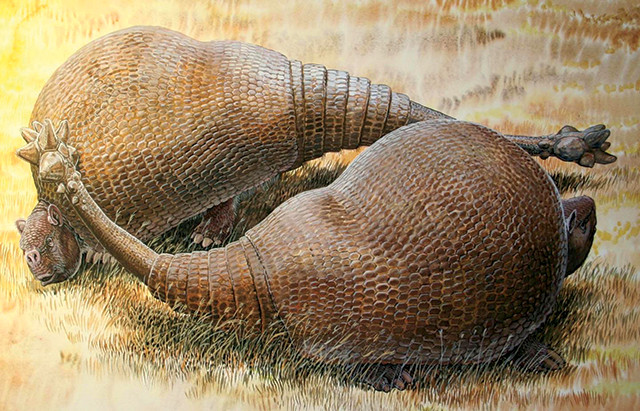
by Mary Caperton Morton Wednesday, June 15, 2016

An illustration of two glyptodonts battling, using their club-like tails for weapons. Credit: Peter Schouten.
Due to coincidences of evolution, extinct creatures sometimes resemble living animals, even if they’re not actually related. But in a new study looking at the family tree of glyptodonts, armored beasts resembling giant armadillos that once roamed South America, researchers have found that the animals actually were early relatives of modern armadillos.
The team, led by Frédéric Delsuc at the University of Montpellier in France, sequenced small fragments of mitochondrial DNA extracted from the armored carapace of Doedicurus, the largest-known glyptodont, which grew to the size of a small car. The molecular evidence, reported in Current Biology, confirmed that glyptodonts didn’t just resemble armadillos, but that they are a distinct subfamily within the family Chlamyphoridae, which includes the pink fairy armadillo, the smallest armadillo living today, among other extant species.
“Glyptodonts in fact represent an extinct lineage that likely originated about 35 million years ago within the armadillo radiation,” said co-author Hendrik Poinar of McMaster University in Ontario, Canada, in a statement.
The findings highlight how glyptodonts’ sizes changed over time. The last common ancestor of glyptodonts and living members of Chlamyphoridae weighed less than 7 kilograms, but the fossil record shows that glyptodonts evolved into 1.5-ton megafauna by the Pleistocene, before going extinct about 11,000 years ago at the end of the last ice age.
Despite their apparent relation to modern armadillos, some of which have articulated, banded carapaces, glyptodonts’ large carapaces were single, unarticulated features. The researchers suggested that “the peculiar structure of their unarticulated carapace might have evolved as a response to the functional constraint imposed by the size increase they experienced over time,” Delsuc said.
© 2008-2021. All rights reserved. Any copying, redistribution or retransmission of any of the contents of this service without the expressed written permission of the American Geosciences Institute is expressly prohibited. Click here for all copyright requests.